Ethical Logistics . org
Tadpole Trikes
Notes collected from the web.
Double wishbone suspension with integrated sway bar.
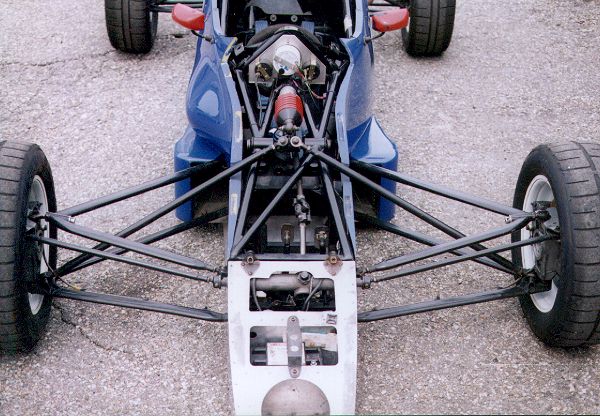
Masa Slingshot

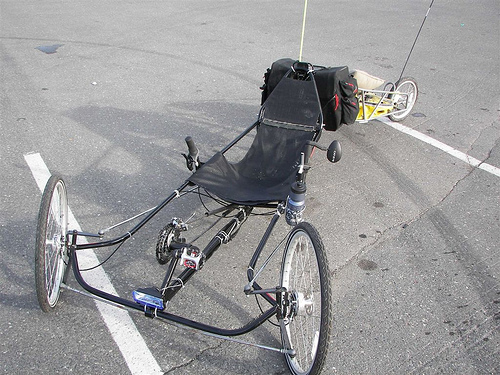
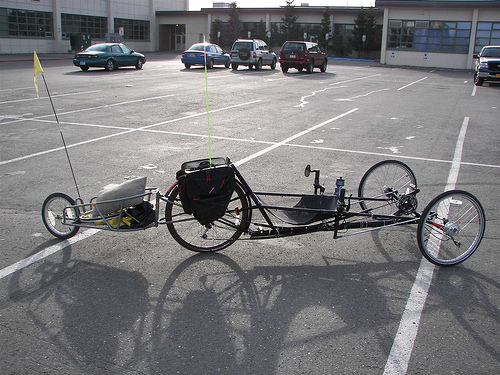



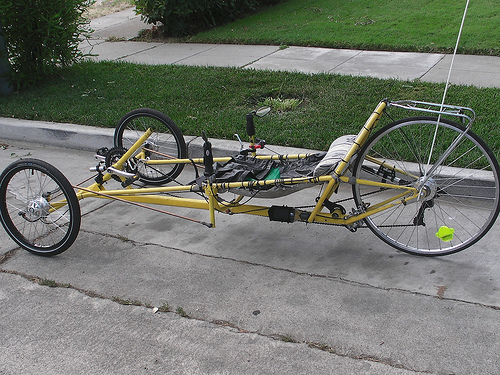
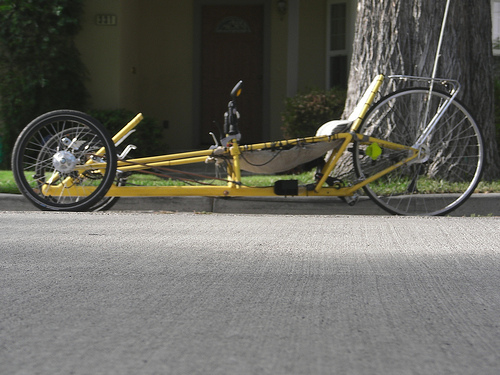

Blast from the past - 1970's MASA Slingshot Recumbent Tadpole Trike
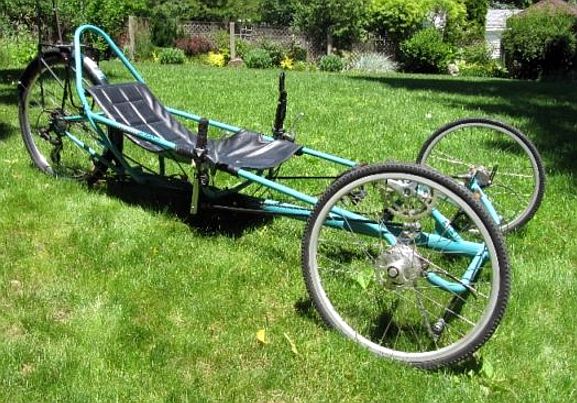
In 1974 MASA (Multi-Advanced Sports Action) (of Japan) created a new class of closed-course track racing. They set up the rules so tight that only one trike would qualify,……their’s! Japanese companies could do that in those days.
MASA was a Japanese company, but targeted the US with this form of racing. In 1975 they finally brought a few of these over here and did some exhibition races between their own staff. It never really caught on, but they still imported about 1500 of these into the US over a three year period.
There were some very minor changes made to the trikes over the three years they were produced, like the rear dropouts, the chain tensioners, seat materials, colors, elimination of a lot of the original chrome parts, and the elimination of the use of a mid-drive that followed the rear der’s movements (called a reciprocal-gearing system).
Since these trikes were focused on track racing only against like trikes, the lack of braking and their size was not a problem. Their wide, long front end was thought to be better protection for the rider.
Two major problems that kept them from becoming popular was the single, minimally effective rear brake and their humongous size (56+lbs). The Slingshot really was intended solely for track racing where braking was only used to adjust speed entering the corners. Even the disc brake on the rear of earlier models was way less than effective for street use. Later models tried the Bendix drum brake on the rear wheel, but still fell short of being able to lock up the wheel. The trike’s 56-65lb weight didn’t help with it’s stopping problems either.
Earlier models came with an aluminum ‘wing” over the front axle, probably more for looks than anything, and a bullet-shaped, sports car-styled rear mirror on the left side. The chain and front sprocket was also completely enclosed in an aluminum guard. They were very high tech looking machines, but too heavy to compete with any other HPV around.
The first year only came in red or yellow, with lots of chrome on the front end. The second and third years offered the orange and black colors, with the loss of all chrome on them, except the rims. The one you have there now is a very late first year model, with a tan seat and simpler, single cog rear jack-shaft on the driveline. It still has some of the chrome on the steering components, but not all. It is a transition model. The seller claims it to be original paint, but that’s not true. Orange wasn’t introduced until all chrome was eliminated. Black also came out first, with all parts painted black, then the orange was added to the frame only.
One last feature that also killed it was it’s tendency to flip over in high speed corners! The rider’s center of mass was closer to the rear wheel than the fronts so it wanted to tip that rear wheel over, and the front wheels couldn’t stop it with so little weight on them. It as about a 30/70% weight distribution on them, front to back, whereas our current generation of tadpole trikes average about 60/40% front to back.
I have a side view drawn to scale. Wheel base is 55" with 3 - 20 inch wheels. Crank center is 9" behind the front wheel center line and 10" above it. Top of seat angles forward form 8" to 10" above ground. Seat back angle is 45 deg. Front edge of the seat is 29" in front of the rear tire center line.
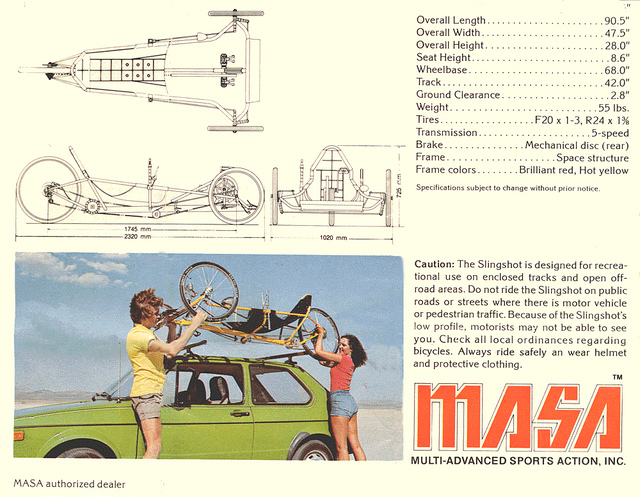
Comparison between Masa and Catrike
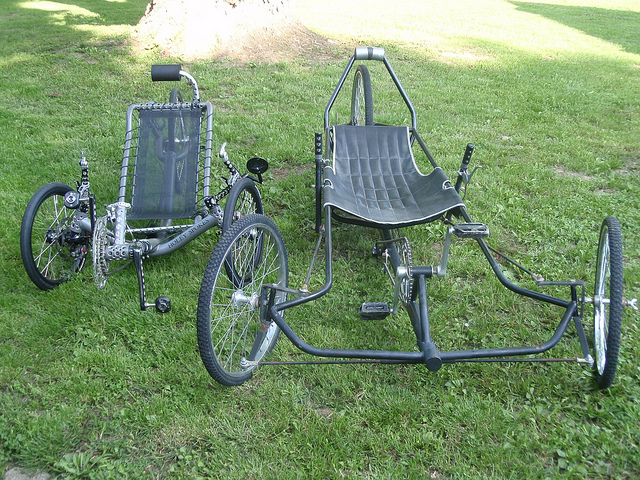
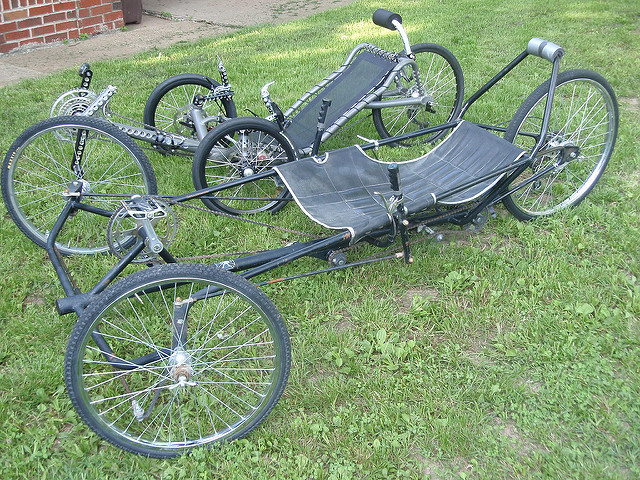

Well, out of all of those ideas you mentioned, the only one that might help is trying to move weight forward, but by sitting more up-right to do that, you are also raising your CG, so it would be a wash as far as gains. Making it a 26 X 3 would also raise the whole trike, magnifying the roll tendency. Better would be to go with 16" fronts and a 20" rear after moving that first jack-shaft on top of the keel-tube.
Yessir, it sure is seductive, but that's about all it has going for it, in stock form. But, is it still a Slingshot if all kinds of things are done to TRY to make it handle like modern tads? One thing I haven't mentioned yet is just how "soft" the rear end is. It has a LOT of twisting flex in it. Even if it didn't tend to roll, it still wouldn't handle well because the rear section of the frame really twists up with very little effort. Even pedaling makes it "waddle" down the street if your spin technique isn't smooth. Looks like a cheap hooker walking!
I just wish you were here to ride my Slingshots and any of my current tadpole trikes! The differences would knock you over!
What performance aspect are you looking for that you think the current models of tadpoles don't offer? The weight balance of most current models is pretty close to perfect for handling high-speed cornering. The only drawback most have found is high-speed panic stops. Yes, they do dive into the pavement! Many chainrings have been ruined due to this.
As I told Gizmo earlier, you have to have a greater portion of the rider's weight over the two front wheels to get them to be effective at holding you up-right in hard turns. The more weight you have over that rear wheel, the more effect it has, and a single wheel will not hold you up when there is heavy side loading, like in fast turns.
I was reading your thread about trying to build a trike with a 52"(?) wheelbase with the cranks behind the front axle/wheels. I would like to see your drawings that tell you it CAN be done. Even the longer trikes, like the 700, have a 45" wheelbase, so fitting the cranks behind that front axle in just another 7" is going to be quite a trick. Even the Slingshot is 68" wheelbase, and they angled the front "axle" crossmember backwards 4" to keep it that short. The issue would be pedals striking that crossmember.
_My investigation into the "golden rule of tricycle design" (having 66% of the weight on the front axle and 33% on the rear) showed that this was more restrictive than necessary, and that following a set of three design guidelines would better and allow greater innovation. These are:
“I'd agree completely with your first paragraph, and the calculations I did in the post about tricycle stability come to equivalent conclusions to you for rollover stability. I'd argue if the CofG height is just "less than half the track and as close to the two-wheel axle as possible", the rollover stabiltiy will be almost as good, without having to calculate exactly. I recommended that keeping the height of the CofG "less than the distance to the front axle" would prevent any stoppies, assuming an absolute maximum of 1g deceleration in any condition. Having the CofG in the front half of the wheelbase stops any speed related instability. For a Tadpole trike, this is unlikely to cause too many problems, with 30/70 weight distribution, the critical speed will be somewhere around 90mph. No real chance of reaching that in a velo! So the rollover stability will become a problem before the critical speed gets low enough to cause a problem. However, for a delta, where the rollover stability gets better as you move the CofG back, it is worth checking that, fully loaded, will bags, etc. the critical speed stays out of the possible speed range, otherwise, the rear might start weaving about by it's self! If the CofG is in the front half, that problem doesn't ever exist.”

Backlinks: Bikes
If you would like to get in touch, I can be reached at
